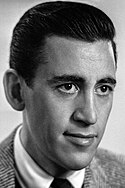J.D. Salinger Quote
Zooey was in dreamy top form. The announcer had them off on the subject of housing developments, and the little Burke girl said she hated houses that all look alike-meaning a long row of identical 'development' houses. Zooey said they were 'nice.' He said it would be very nice to come home and be in the wrong house. To eat dinner with the wrong people by mistake, sleep in the wrong bed by mistake, and kiss everybody goodbye in the morning thinking they were your own family. He said he even wished everybody in the world looked exactly alike. He said you'd keep thinking everybody you met was your wife or your mother or father, and people would always be throwing their arms around each other wherever they went, and it would look 'very nice.
Zooey was in dreamy top form. The announcer had them off on the subject of housing developments, and the little Burke girl said she hated houses that all look alike-meaning a long row of identical 'development' houses. Zooey said they were 'nice.' He said it would be very nice to come home and be in the wrong house. To eat dinner with the wrong people by mistake, sleep in the wrong bed by mistake, and kiss everybody goodbye in the morning thinking they were your own family. He said he even wished everybody in the world looked exactly alike. He said you'd keep thinking everybody you met was your wife or your mother or father, and people would always be throwing their arms around each other wherever they went, and it would look 'very nice.
Related Quotes
About J.D. Salinger
The Catcher in the Rye (1951) was an immediate popular success; Salinger's depiction of adolescent alienation and loss of innocence was influential, especially among adolescent readers. The novel was widely read and controversial, and its success led to public attention and scrutiny. Salinger became reclusive, publishing less frequently. He followed Catcher with a short story collection, Nine Stories (1953); Franny and Zooey (1961), a volume containing a novella and a short story; and a volume containing two novellas, Raise High the Roof Beam, Carpenters and Seymour: An Introduction (1963). Salinger's last published work, the novella Hapworth 16, 1924, appeared in The New Yorker on June 19, 1965.
Afterward, Salinger struggled with unwanted attention, including a legal battle in the 1980s with biographer Ian Hamilton and the release in the late 1990s of memoirs written by two people close to him: Joyce Maynard, an ex-lover; and his daughter, Margaret Salinger.
